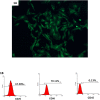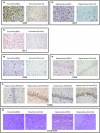Interactome and reciprocal activation of pathways in topical mesenchymal stem cells and the recipient cerebral cortex following traumatic brain injury
- PMID: 28694468
- PMCID: PMC5504061
- DOI: 10.1038/s41598-017-01772-7
Interactome and reciprocal activation of pathways in topical mesenchymal stem cells and the recipient cerebral cortex following traumatic brain injury
Abstract
In this study, GFP-MSCs were topically applied to the surface of cerebral cortex within 1 hour of experimental TBI. No treatment was given to the control group. Three days after topical application, the MSCs homed to the injured parenchyma and improved the neurological function. Topical MSCs triggered earlier astrocytosis and reactive microglia. TBI penumbra and hippocampus had higher cellular proliferation. Apoptosis was suppressed at hippocampus at 1 week and reduced neuronal damaged was found in the penumbral at day 14 apoptosis. Proteolytic neuronal injury biomarkers (alphaII-spectrin breakdown products, SBDPs) and glial cell injury biomarker, glial fibrillary acidic protein (GFAP)-breakdown product (GBDPs) in injured cortex were also attenuated by MSCs. In the penumbra, six genes related to axongenesis (Erbb2); growth factors (Artn, Ptn); cytokine (IL3); cell cycle (Hdac4); and notch signaling (Hes1) were up-regulated three days after MSC transplant. Transcriptome analysis demonstrated that 7,943 genes were differentially expressed and 94 signaling pathways were activated in the topical MSCs transplanted onto the cortex of brain injured rats with TBI. In conclusion, topical application offers a direct and efficient delivery of MSCs to the brain.
Conflict of interest statement
The authors declare that they have no competing interests.
Figures






References
-
- Rubio D, et al. Spontaneous human adult stem cell transformation. Cancer Res. 2005;65:3035–3039. - PubMed
Publication types
MeSH terms
Substances
LinkOut - more resources
Full Text Sources
Other Literature Sources
Medical
Research Materials
Miscellaneous

